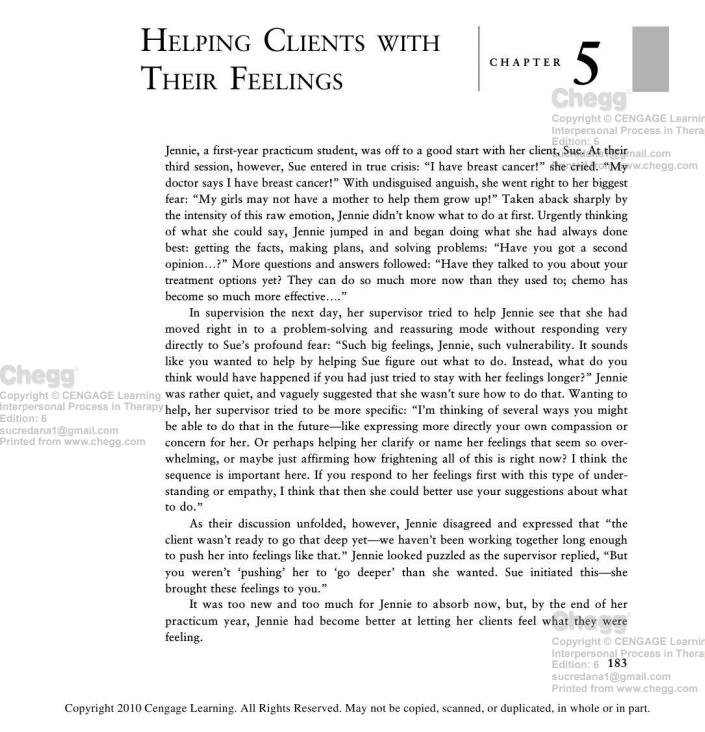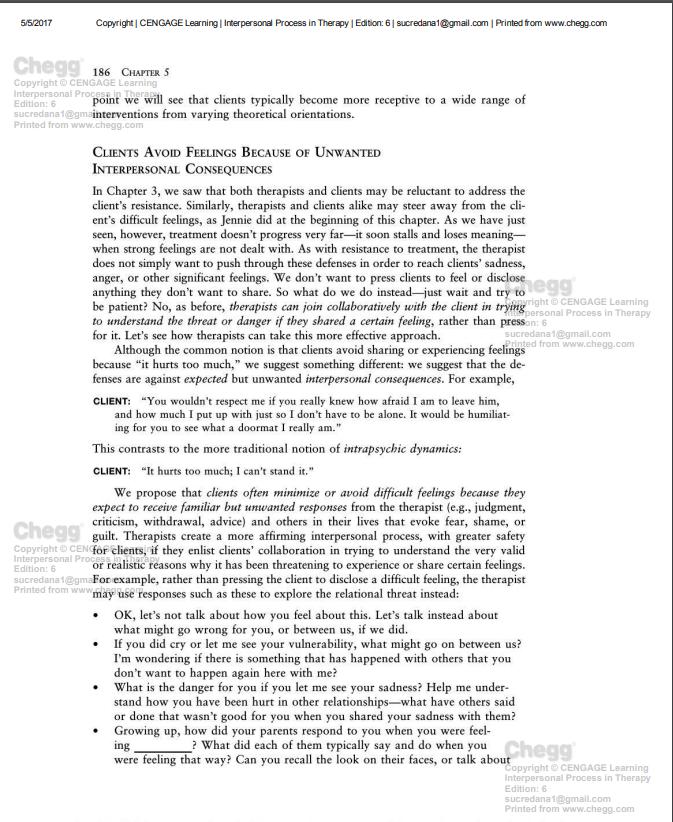Answered step by step
Verified Expert Solution
Question
1 Approved Answer
read the case and DO Interpersonal Therapy Analysis: HELPING CLIENTS WITH THEIR FEELINGS 5 Chegg sucredana1@gmail.com Printed from www.chegg.com CHAPTER Copyright CENGAGE Learnin Interpersonal Process
read the case and DO Interpersonal Therapy Analysis:




HELPING CLIENTS WITH THEIR FEELINGS 5 Chegg sucredana1@gmail.com Printed from www.chegg.com CHAPTER Copyright CENGAGE Learnin Interpersonal Process in Thera Edition: 6 Jennie, a first-year practicum student, was off to a good start with her client, Sue. At their mail.com third session, however, Sue entered in true crisis: I have breast cancer! she cried. Myw.chegg.com doctor says I have breast cancer! With undisguised anguish, she went right to her biggest fear: My girls may not have a mother to help them grow up! Taken aback sharply by the intensity of this raw emotion, Jennie didn t know what to do at first. Urgently thinking of what she could say, Jennie jumped in and began doing what she had always done best: getting the facts, making plans, and solving problems: Have you got a second opinion...? More questions and answers followed: Have they talked to you about your treatment options yet? They can do so much more now than they used to; chemo has become so much more effective.... In supervision the next day, her supervisor tried to help Jennie see that she had moved right in to a problem-solving and reassuring mode without responding very directly to Sue s profound fear: Such big feelings, Jennie, such vulnerability. It sounds like you wanted to help by helping Sue figure out what to do. Instead, what do you think would have happened if you had just tried to stay with her feelings longer? Jennie Copyright CENGAGE Learning was rather quiet, and vaguely suggested that she wasn t sure how to do that. Wanting to Interpersonal Process in Therapy help, her supervisor tried to be more specific: I m thinking of several ways you might Chegg Edition: 6 be able to do that in the future-like expressing more directly your own compassion or concern for her. Or perhaps helping her clarify or name her feelings that seem so over- whelming, or maybe just affirming how frightening all of this is right now? I think the sequence is important here. If you respond to her feelings first with this type of under- standing or empathy, I think that then she could better use your suggestions about what to do. As their discussion unfolded, however, Jennie disagreed and expressed that the client wasn t ready to go that deep yet-we haven t been working together long enough to push her into feelings like that. Jennie looked puzzled as the supervisor replied, But you weren t pushing her to go deeper than she wanted. Sue initiated this-she brought these feelings to you. It was too new and too much for Jennie to absorb now, but, by the end of her practicum year, Jennie had become better at letting her clients feel what they were feeling. Copyright CENGAGE Learnin Interpersonal Process in Thera Edition: 6 183 sucredana1@gmail.com Printed from www.chegg.com Copyright 2010 Cengage Learning. All Rights Reserved. May not be copied, scanned, or duplicated, in whole or in part. Chegg 184 CHAPTER 5 Copyright CENGAGE Learning Interpersonal Process in Therapy Edition: 6 CONCEPTUAL OVERVIEW Printed from www.Painful feelings lie at the heart of enduring problems, and therapists help clients change when they respond effectively to them. When the therapist focuses clients inward on their own experience, clients will begin to feel more intensely, and ex- press more directly, the difficult feelings that accompany their problems. This affec- tive unfolding is a pivotal point in treatment. It highlights or reveals the conflicted feelings that are central to the clients problems-clarifying what s really wrong; and it makes these important feelings, that have not been responded to well in the past, accessible for the therapist to respond to and work with. On the one hand, clients will welcome the promise of having therapists make contact with them on this deeper, more personal or feeling level. But on the other hand, clients still fear and may want to avoid feelings that have been unacceptable in other relationships- or that just seem too painful, shameful, or hopelessly unsolvable. Thus the therapist s egg response to the challenging feelings that clients bring will have a pivotal impact on the right CENGAGE Learnin outcome of treatment, and this chapter will help therapists learn much more aboutpersonal Process in Therap helpful ways to respond. Edition: 6 sucredana1@gmail.com Therapists facilitate change by providing a more helpful response to the client sed from www.chegg.com feelings than he has come to expect from others (that is, the therapist validates these, takes them seriously, and does not minimize them or offer superficial reassur- ances). Furthermore, when therapists avoid or do not respond to the client s feel- ings, the therapeutic relationship loses its vitality and meaning treatment is reduced to an intellectual pursuit. Thus, the purpose of this chapter is to help thera- pists respond effectively to the feelings evoked when clients look within. Before starting, however, let s begin this chapter with a note of encouragement and an eye toward realistic expectations for new therapists. The material presented in this chapter is more personally evocative and challenging for many therapists than the material presented in other chapters. The issues discussed here often evoke personal concerns for therapists in training, and these principles are difficult to readily apply with clients. Understanding these processes intellectually is a realistic Chegg goal for first-year therapists; being able to utilize these interventions effectively in Copyright CENambiguous therapeutic interactions is not. Be patient: In a year or two, you will be Interpersonal Proable to integrate these suggestions and make many of these interventions your own. Like so many things, learning this comes with practice. Edition: 6 sucredana1@gmail.com Printed from www.chegg.com RESPONDING TO CLIENTS FEELINGS WORK WITH CLIENTS AMBIVALENCE ABOUT ADDRESSING THEIR FEELINGS Many of the problems that clients present can be resolved by trying out new coping strategies or behavioral alternatives, questioning faulty beliefs, or reframing problems in a new perspective. These brief interventions are sufficient to help with many of the difficulties clients present, and they are an important aspect of change for most pro- blems. However, for the more enduring and pervasive problems that clients often present, the conflicted emotions that accompany their difficulties need to be addressed egg as well. Psychotherapy process studies have demonstrated that positive outcomes are right CENGAGE Learnin Interpersonal Process in Therap Edition: 6 sucredana1@gmail.com Printed from www.chegg.com Copyright 2010 Cengage Learning. All Rights Reserved. May not be copied, scanned, or duplicated, in whole or in part. 5/5/2017 Copyright | CENGAGE Learning Interpersonal Process in Therapy | Edition: 6 | sucredana1@gmail.com | Printed from www.chegg.com Chegg HELPING CLIENTS WITH THEIR FEELINGS 185 Copyright CENGAGE Learning Interpersonal Process in the associated with therapist interventions that facilitate clients emotional experiencing Edition: 6 and encourage verbalization of affect (Diener et al., 2007). sucredana1@gmail.com Printed from www.chegg.com At times, clients may be reluctant or ambivalent about exploring more fully the difficult feelings that emerge in treatment. On the one hand, clients hope that the therapist will be able to help with their emotional reactions; on the other, they may want to avoid the difficult feelings that they have not been able to resolve on their own. This reluctance emerges in the beginning for many different reasons. To the client, it may seem pointless: To share the same painful feelings again when-based on what has happened before they have scant hope of receiving help; To suffer shame by revealing secrets, failure experiences, or feelings of inadequacy; To risk unwanted but expected judgment from the therapist for having feelings that have always seemed unacceptable; To struggle with their own fear of losing control. Copyright CENGAGE Learnin Interpersonal Process in Thera Edition: 6 As a result of these and other concerns, clients sometimes resist the therapist small.com attempts to touch the emotional core of their experience. At the same time, howw.chegg.com ever, they often long for this empathic understanding as well. The hope is that: Someone may, at last, truly listen to them with deep understanding or compassion rather than criticism or blame. Their experiences might, in fact, be validated. They no longer have to be alone with the shame, anxiety, anger, guilt, or other form of distress that they have felt so alone with. They can begin the process of connecting meaningfully with another person and have a relationship characterized by trust. Chegg Once the therapist recognizes the client s relational schemas and understands how significant others have characteristically responded to the client s vulnerability in the past, the fear or shame that motivates her ambivalence will make sense. As out- lined in Appendix B, therapists can generate working hypotheses and try to anticipate Copyright CENGAGE Lear clients potential response to conflicted feelings and attempt to work with those feel- Interpersonal Process in Theings rather than avoid them. If not, treatment will be just an intellectual exercise that will not be sufficiently potent to propel meaningful and enduring change. (Following Printed from www.chegg.comGoldfried, extrapolations from cognitive science and cognitive neuroscience all point to the need for affective arousal in order to reorganize meaning structures (Goldfried, 2006; Samoilov & Goldfried, 2000).) In sum, the therapist can appreciate the client s reluctance to approach certain feelings yet also keep in mind the client s simultaneous wish to be responded to in this deeply personal way. Edition: 6 sucredana1@gmail.com Although difficult emotions are central to most clients problems, the therapist s affirming response to these feelings also provides the avenue to resolution and change. The corrective emotional experience that the therapist provides to clients- the experience of sharing important feelings with another who remains connected and validating-loosens the hold of faulty beliefs and expectations. As rigid schemas become more flexible and expand, clients are empowered to make the changes they desire. At this critical juncture when clients experience a reparative or corrective re- sponse to such significant feelings, the treatment process springs forward. At this NGAGE Learni interpersonal Process in Thera Edition: 6 sucredana1@gmail.com Printed from www.chegg.com Copyright 2010 Cengage Learning. All Rights Reserved. May not be copied, scanned, or duplicated, in whole or in part. 5/5/2017 Copyright | CENGAGE Learning | Interpersonal Process in Therapy | Edition: 6 | sucredana1@gmail.com | Printed from www.chegg.com Chegg 186 CHAPTER 5 Copyright CENGAGE Learning Interpersonal Propoint we will see that clients typically become more receptive to a wide range of from varying theoretical orientations. Edition: 6 sucradana1@gmainterventions Printed from www.chegg.com CLIENTS AVOID FEELINGS BECAUSE OF UNWANTED INTERPERSONAL CONSEQUENCES In Chapter 3, we saw that both therapists and clients may be reluctant to address the client s resistance. Similarly, therapists and clients alike may steer away from the cli- ent s difficult feelings, as Jennie did at the beginning of this chapter. As we have just seen, however, treatment doesn t progress very far-it soon stalls and loses meaning- when strong feelings are not dealt with. As with resistance to treatment, the therapist does not simply want to push through these defenses in order to reach clients sadness, anger, or other significant feelings. We don t want to press clients to feel or disclose egg anything they want what do we wait and try to personal Process in Therapy be patient? No, as before, therapists can join collaboratively with the client in trying right@CENGAGE Learning to understand the threat or danger if they shared a certain feeling, rather than presson: 6 for it. Let s see how therapists can take this more effective approach. sucredana1@gmail.com Although the common notion is that clients avoid sharing or experiencing feelings from www.chegg.com because it hurts too much, we suggest something different: we suggest that the de- fenses are against expected but unwanted interpersonal consequences. For example, CLIENT: You wouldn t respect me if you really knew how afraid I am to leave him, and how much I put up with just so I don t have to be alone. It would be humiliat- ing for you to see what a doormat I really am. This contrasts to the more traditional notion of intrapsychic dynamics: CLIENT: It hurts too much; I can t stand it. Chegg We propose that clients often minimize or avoid difficult feelings because they expect to receive familiar but unwanted responses from the therapist (e.g., judgment, criticism, withdrawal, advice) and others in their lives that evoke fear, shame, or guilt. Therapists create a more affirming interpersonal process, with greater safety Copyright for clients, if they enlist clients collaboration in trying to understand the very valid Interpersonal Pror realistic reasons why it has been threatening to experience or share certain feelings. sucredana1@gmaFor example, rather than pressing the client to disclose a difficult feeling, the therapist Printed from www.may i use responses such as these to explore the relational threat instead: Edition: 6 OK, let s not talk about how you feel about this. Let s talk instead about what might go wrong for you, or between us, if we did. If you did cry or let me see your vulnerability, what might go on between us? I m wondering if there is something that has happened with others that you don t want to happen again here with me? What is the danger for you if you let me see your sadness? Help me under- stand how you have been hurt in other relationships-what have others said or done that wasn t good for you when you shared your sadness with them? Growing up, how did your parents respond to you when you were feel- ing were feeling that way? Can you recall the look on their faces, or talk about ? What did each of them typically say and do when you Chegg Copyright CENGAGE Learning Interpersonal Process in Therapy Edition: 6 sucredana1@gmail.com Printed from www.chegg.com
Step by Step Solution
There are 3 Steps involved in it
Step: 1
Interpersonal Therapy Analysis Interpersonal therapy concentrates on interpersonal relations of a client with difficult feelings or depressed situation The concept of interpersonal therapy implies tha...
Get Instant Access to Expert-Tailored Solutions
See step-by-step solutions with expert insights and AI powered tools for academic success
Step: 2

Step: 3

Ace Your Homework with AI
Get the answers you need in no time with our AI-driven, step-by-step assistance
Get Started


